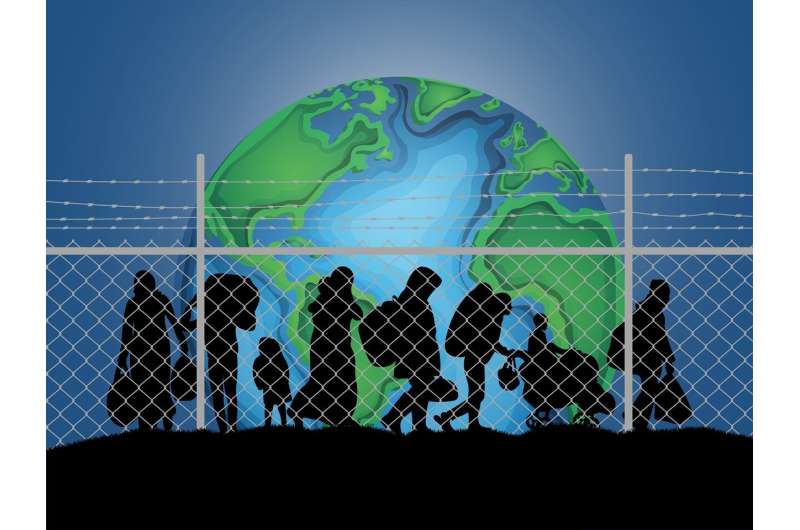Four things to know about climate change and human migration

Lisa Lock
scientific editor

Robert Egan
associate editor

Climate change is making some regions less habitable for humans, whether by raising sea levels, hurting crop yields, or intensifying droughts, storms, and wildfires. Yet, if you ask people why they're moving, few say it's for climate reasons, said Hélène Benveniste, an assistant professor of environmental social sciences at the Stanford Doerr School of Sustainability.
Climate change tends to affect migration patterns in subtle ways, Benveniste explained. In her research, she uses statistical and modeling methods to find the climate signal among the numerous other pressures influencing migration.
"Basically, climate change influences pre-existing migration flows," she said. There isn't a single effect. Rather, she said, "climate change is both increasing the number of people who are forced to move and increasing the number of people who are forced to stay."
Here are four essential facts about climate and human migration based on Benveniste's research.
Middle-income groups are the most likely to migrate in response to climate risks.
Researchers over the past decade have found that groups with incomes near the average for their region are the most likely to migrate in response to rising seas, extreme droughts and storms, and other climate-related impacts. These middle-income groups have just enough resources to find less risky places to live.
Those with the highest and lowest incomes are less likely to migrate in response to climate impacts. The poorest people typically don't have the means to move, while the wealthiest often have the resources to adapt without moving. Benveniste noted how during the Los Angeles fires in January 2025, some of the wealthiest homeowners were able to save their homes by hiring private firefighting crews, while others watched theirs burn.
As climate change increases the number of people who want to migrate but can't, it leaves some communities exposed to greater risks.
Climate migration has two dimensions: the aspiration to move, and the ability to move. Although more research is needed to quantify global trends, Benveniste said climate change appears to be increasing the number of people who want to move but can't, a state called involuntary immobility.
In a 2022 study, Benveniste and co-authors estimated that emigration among low-income populations will be 10% lower in 2100 under climate change than it would be in a scenario with no warming.
"Climate change often depletes resources, including for very vulnerable communities," said Benveniste, the Steven and Roberta Denning Faculty Fellow in Global Governance for Sustainability. These immobile populations then become more exposed to climate risks, because they can't escape.
Other researchers have found smallholder farmers in Nepal are at risk of climate-caused immobility, for example. These farmers often send a family member to find work abroad and send money back, which can buffer bad harvests. But when crops in Nepal fail due to climate impacts such as extreme droughts, the farmers may not be able to afford travel costs. In that case, they are even worse off because climate change is impacting their crops at home and their access to a financial buffer.
"The presence or absence of migration does not tell you everything you need to know," said Benveniste. "It might be the case that a decrease in migration is actually a reflection of an increase in vulnerability to environmental stress."
People migrating out of middle- and lower-income countries tend to move to places with lower climate risk.
Border policies can potentially increase vulnerability to impacts from climate change, Benveniste and colleagues at Princeton University found in a 2020 analysis. In the study, the researchers asked, "When people migrate internationally, do they end up moving to places where they are less exposed and vulnerable to climate risk than where they came from?"
The answer, on average, was yes. Especially when people migrate out of middle- and lower-income countries, they tend to move to new locations with lower climate risk. More restrictive border policies shrink this flow of people to places with lower climate risk. "They end up staying in areas where they're more exposed," said Benveniste.
International cooperation can reduce climate vulnerability.
By 2050, global warming is projected to expose nearly all refugee camps around the world to more days of hazardous heat; some of the hottest camp locations could see twice as many hazardous heat days, where the is above 30°C (86°F).
Accounting for this and other examples of rising risks associated with involuntary immobility under climate change can help national governments make more informed decisions about cross-border migration and climate adaptation strategies, according to Benveniste and co-authors of a recent perspective article in Nature Communications.
Some bilateral agreements have begun to take shape. For example, a 2023 agreement between Australia and Tuvalu created a path to permanent residency in Australia for citizens of the small island nation, where sea levels are rising about one and a half times faster than the global average—although not without criticism for giving Australia .
Other intergovernmental efforts, such as the UN's Global Compact for Migration, Framework Convention on Climate Change, and Refugee Agency, are taking steps to prepare for climate-related migration or immobility. But more work is needed, said Benveniste. "There is no clear governance framework at the international level that fully addresses these issues," she said.
Journal information: Nature Communications
Provided by Stanford University

















